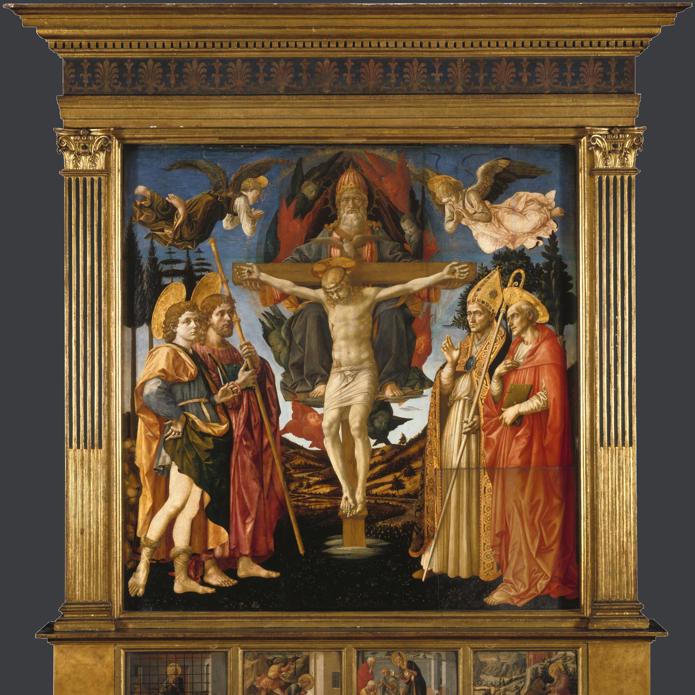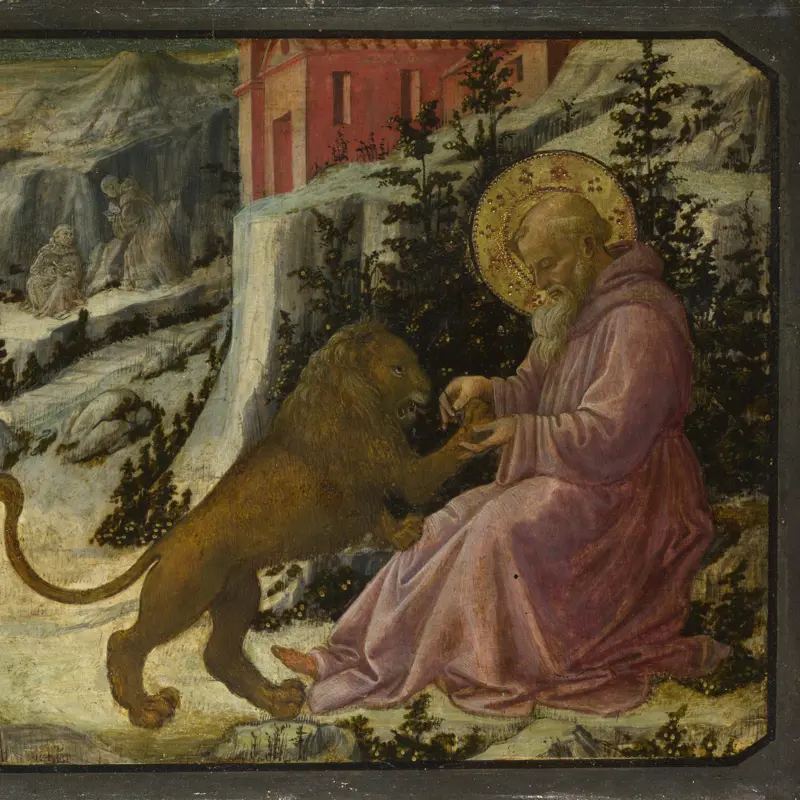Francesco Pesellino and Fra Filippo Lippi and Workshop, 'Saints Mamas and James', 1455-60
About the work
Overview
These saints come from a large pala (an altarpiece with a single, unified surface) which was sawn into pieces in the eighteenth century and later reassembled in the National Gallery. Look closely and you can see lines where the fragments were put back together. The altarpiece was begun by Francesco Pesellino and finished by Filippo Lippi after Pesellino’s death in 1457. It took five years to complete.
It was commissioned by a confraternity of priests in Pistoia, and the saints shown are those who were special to them. Saint James, behind, with his pilgrim’s staff, was patron of Pistoia cathedral, while the youthful Saint Mamas was the favourite saint of Per ser Landi, the confraternity’s treasurer, who managed the commission and oversaw the work.
Key facts
Details
- Full title
- Saints Mamas and James
- Artist
- Francesco Pesellino and Fra Filippo Lippi and Workshop
- Artist dates
- 1422 - 1457; born about 1406; died 1469
- Part of the group
- The Pistoia Santa Trinità Altarpiece
- Date made
- 1455-60
- Medium and support
- Egg tempera, tempera grassa and oil on wood
- Dimensions
- 142 × 64.5 cm
- Acquisition credit
- On loan from His Majesty The King
- Inventory number
- L15
- Location
- Room 60
- Image copyright
- On loan from His Majesty The King, © Royal Collection Enterprises Limited 2024 | Royal Collection Trust
- Collection
- Main Collection
- Frame
- 20th-century Replica Frame
Frame
This is a twentieth-century reproduction frame, made by an unknown workshop in Paris. Constructed in pine with water gilding, the altar frame features pilasters with gilt-stopped fluting in blue and gold, crowned by Corinthian capitals. The entablature, with an intricately painted frieze in gold and blue, showcases palmetto motifs.
The creation of the reproduction frame was arranged in 1929 by the art dealer Joseph Duveen (1869–1939). It replicates the frame that originally housed The Holy Trinity by Donnino and Angelo di Domenico del Mazziere, in the Church of Santa Spirito, Florence. Hidden ornaments lie underneath the loaned panels.
The reproduction predella frame was crafted at the Gallery in the 1990s to house four individual panel paintings. It was constructed with vertical divisions and water-gilded to match the altar frame.
The altar frame of the original Pistoia Santa Trinità Altarpiece was lost when its panel was cut into pieces in 1783.
About this record
If you know more about this work or have spotted an error, please contact us. Please note that exhibition histories are listed from 2009 onwards. Bibliographies may not be complete; more comprehensive information is available in the National Gallery Library.
Images
About the group: The Pistoia Santa Trinità Altarpiece

Overview
This large altarpiece – one of the few in the National Gallery which is almost complete – has had an eventful life. It was commissioned in 1455 from the Florentine painter Francesco Pesellino, and is his only surviving documented work. He died in 1457 and it was finished by Fra Filippo Lippi and his workshop. We know a lot about how and why it was made from the records of the confraternity who commissioned it.
From 1465 it sat on the high altar of the church of the Holy Trinity at Pistoia, but in 1793 the confraternity was suppressed and the altarpiece was taken apart, with the main panel sawn into pieces, and dispersed. Most of it was gradually acquired by the National Gallery and the altarpiece reassembled.
This is the earliest pala (an altarpiece with a single main panel) in the National Gallery.
















